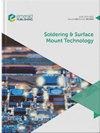微电子技术中SnAgCu无铅焊料热界面材料的可靠性分析
IF 1.7
4区 材料科学
Q3 ENGINEERING, ELECTRICAL & ELECTRONIC
引用次数: 1
摘要
目的在微电子工业中,其部件的可靠性是工程师们关注的一个主要领域。因此,必须使用现有最可靠的材料来解决这些问题。热接口材料(TIM)用于电子设备中,以桥接散热器和倒装芯片组件之间的拓扑结构。因此,本研究旨在研究SAC405和SAC396在微电子组件中的可靠性。设计/方法/方法本文使用SnAgCu焊料合金(SAC405和SAC396)作为TIM。该模型由芯片、TIM和散热器底座组成,采用ANSYS有限元分析软件开发,并在-40°C至85°C的热循环载荷下进行了模拟。结果分析表明,SAC405比SAC396更可靠。这一点在疲劳寿命分析中很明显,预测疲劳寿命约为85 SAC405失败需要几天时间,而它花了大约13天时间 SAC396失败的天数。因此,根据本次调查结果,与SAC396相比,SAC405被推荐为TIM的首选。原创性/价值本文主要研究用作TIM的SnAgCu焊料。本文证明SAC405是一种可靠的焊料TIM。这可以指导电子产品制造商在组装过程中决定使用哪种SAC焊料作为TIM。本文章由计算机程序翻译,如有差异,请以英文原文为准。
Reliability analysis of SnAgCu lead-free solder thermal interface materials in microelectronics
Purpose
In microelectronics industry, the reliability of its components is a major area of concern for engineers. Therefore, it is imperative that such concerns are addressed by using the most reliable materials available. Thermal interface materials (TIMs) are used in electronic devices to bridge the topologies that exists between a heat sink and the flip chip assembly. Therefore, this study aims to investigate the reliability of SAC405 and SAC396 in a microelectronics assembly.
Design/methodology/approach
In this paper, SnAgCu solder alloys (SAC405 and SAC396) were used as the TIMs. The model, which comprises the chip, TIM and heat sink base, was developed with ANSYS finite element analysis software and simulated under a thermal cycling load of between −40°C and 85°C.
Findings
The results obtained from this paper were based on the total deformation, stress, strain and fatigue life of the lead-free solder materials. The analyses of the results showed that SAC405 is more reliable than SAC396. This was evident in the fatigue life analysis where it was predicted that it took about 85 days for SAC405 to fail, whereas it took about 13 days for SAC396 to fail. Therefore, SAC405 is recommended as the TIM of choice compared to SAC396 based upon the findings of this investigation.
Originality/value
This paper is centred on SnAgCu solders used as TIMs. This paper demonstrated that SAC405 is a reliable solder TIM. This can guide manufacturers of electronic products in deciding which SAC solder to apply as TIM during the assembly process.
求助全文
通过发布文献求助,成功后即可免费获取论文全文。
去求助
来源期刊

Soldering & Surface Mount Technology
工程技术-材料科学:综合
CiteScore
4.10
自引率
15.00%
发文量
30
审稿时长
>12 weeks
期刊介绍:
Soldering & Surface Mount Technology seeks to make an important contribution to the advancement of research and application within the technical body of knowledge and expertise in this vital area. Soldering & Surface Mount Technology compliments its sister publications; Circuit World and Microelectronics International.
The journal covers all aspects of SMT from alloys, pastes and fluxes, to reliability and environmental effects, and is currently providing an important dissemination route for new knowledge on lead-free solders and processes. The journal comprises a multidisciplinary study of the key materials and technologies used to assemble state of the art functional electronic devices. The key focus is on assembling devices and interconnecting components via soldering, whilst also embracing a broad range of related approaches.
 求助内容:
求助内容: 应助结果提醒方式:
应助结果提醒方式:


